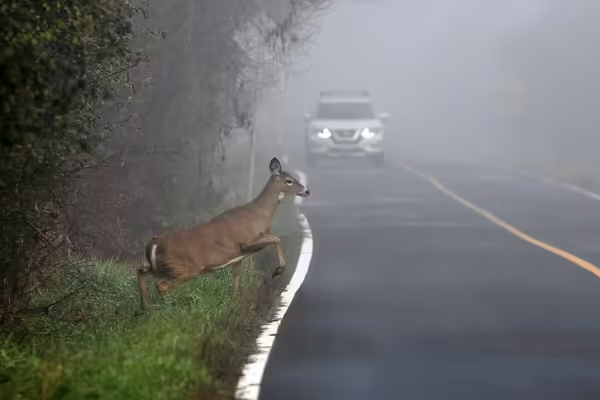
URBANA, Ill. — This Sunday at 2 a.m. Central Standard Time, daylight saving time will end, with clocks set back one hour. One of the most noticeable effects of “falling back” is that people will find themselves driving home from work or for after-school activities as the sun sets, putting them on the road and at risk for collisions with many wildlife that are active at that time.
The tradition of daylight saving time has a long history, with reasons for its implementation ranging from maintaining daylight during work and school to conserving energy and boosting the economy through extended shopping hours. However, research has shown that the end of daylight saving time in the fall can lead to an increase in wildlife vehicle collisions. Studies across the U.S. have tracked white-tailed deer vehicle collision rates in relation to time changes, with some showing a 16% spike in deer-vehicle collisions after the fall time shift. Collisions also tend to decrease after the clocks “spring forward” in March. Reduced visibility and driver fatigue caused by disrupted sleep schedules can further increase the risk of collisions following the time change.
“As we transition into darker evenings, drivers should stay alert and be aware of wildlife activity near roads to avoid collisions,” said Karla Griesbaum, University of Illinois Extension natural resources, environment, and energy educator. “Not all collisions can be prevented, but drivers can reduce their risk by understanding wildlife behavior.”
White-tailed deer, coyotes, rabbits, foxes, moths, fireflies, some bees, and other wildlife are crepuscular, meaning they are most active at dawn and dusk. These animals have adapted to be active during these times to avoid predators, enhance camouflage, and take advantage of cooler temperatures in the summer. Hunting seasons and animal mating behaviors also contribute to increased wildlife activity in the fall.
In the case of white-tailed deer, human activity can also influence their movement, such as when they gather in cornfields and traffic flows at certain times of the day. When this pattern changes suddenly, it will take wildlife a few weeks to readjust. An estimated 1 million vertebrate wildlife are killed by vehicles every day in the U.S., and a collision with any large animal can be costly.
“Wildlife vehicle collisions are a lose-lose situation. They are most often fatal for the animal and potentially harmful to the people involved,” Griesbaum said.
When driving at night, reduce your speed, keep a safe distance from other vehicles, and be prepared to stop. Scan roadsides for “eyeshine,” which is the reflection of headlights in an animal’s eyes, and use high-beam lights when appropriate. Watch out for wildlife in areas near woodlots, field edges, waterways, and places they have been spotted in the past.
If animals are on the roadway, avoid slamming on the brakes or swerving into traffic or off the road; this can cause a loss of control of the vehicle. Slow to a stop, flash your headlights, and honk the car horn to encourage animals to move off the road. If an animal is struck, safely pull off the road, assess the situation, and call 911 if needed. It is illegal for anyone except a law enforcement officer to kill a crippled animal. Deer killed in a vehicle collision can be legally claimed by any Illinois citizen. Claims must be reported to the Illinois Department of Natural Resources within 24 hours by calling (217) 782-6431 or online at deer.wildlifeillinois.org.
Explore more about navigating human-wildlife interactions on Illinois Extension’s wildlife website at extension.illinois.edu/wildlife.
Extension’s natural resources, environment, and energy program provides research-based education for awareness and action to sustain healthy environments and ecosystems that support quality living and resilient communities. Extension staff empower people across Illinois to make a difference through the community volunteer programs Master Naturalists, Climate Stewards, and Master Watershed Stewards.
More information
- Extension website: Illinois Wildlife
- Highway to harm – the hidden toll of roads on wildlife
- Deer behavior: Effect of Daylight Saving Time clock shifts on white-tailed deer-vehicle collision rates, A Review of White-Tailed Deer Movements in the Great Plains Relative to Environmental Conditions, Activity and the Movements of Female White-Tailed Deer During the Rut
- Animals at dawn and dusk: The advantages of being crepuscular for bees, The diversity of temporal niches in mammals
Source: Karla Griesbaum, Illinois Extension natural resources, environment, and energy educator serving Champaign, Ford, Iroquois and Vermilion Counties.
University of Illinois Extension develops educational programs, extends knowledge, and builds partnerships to support people, communities, and their environments as part of the state's land-grant institution. Extension serves as the leading public outreach effort for University of Illinois Urbana-Champaign and the College of Agricultural, Consumer and Environmental Sciences in all 102 Illinois counties through a network of 27 multi-county units and over 700 staff statewide. Extension’s mission is responsive to eight strategic priorities — community, economy, environment, food and agriculture, health, partnerships, technology and discovery, and workforce excellence — that are served through six program areas — 4-H youth development, agriculture and agribusiness, community and economic development, family and consumer science, integrated health disparities, and natural resources, environment, and energy.